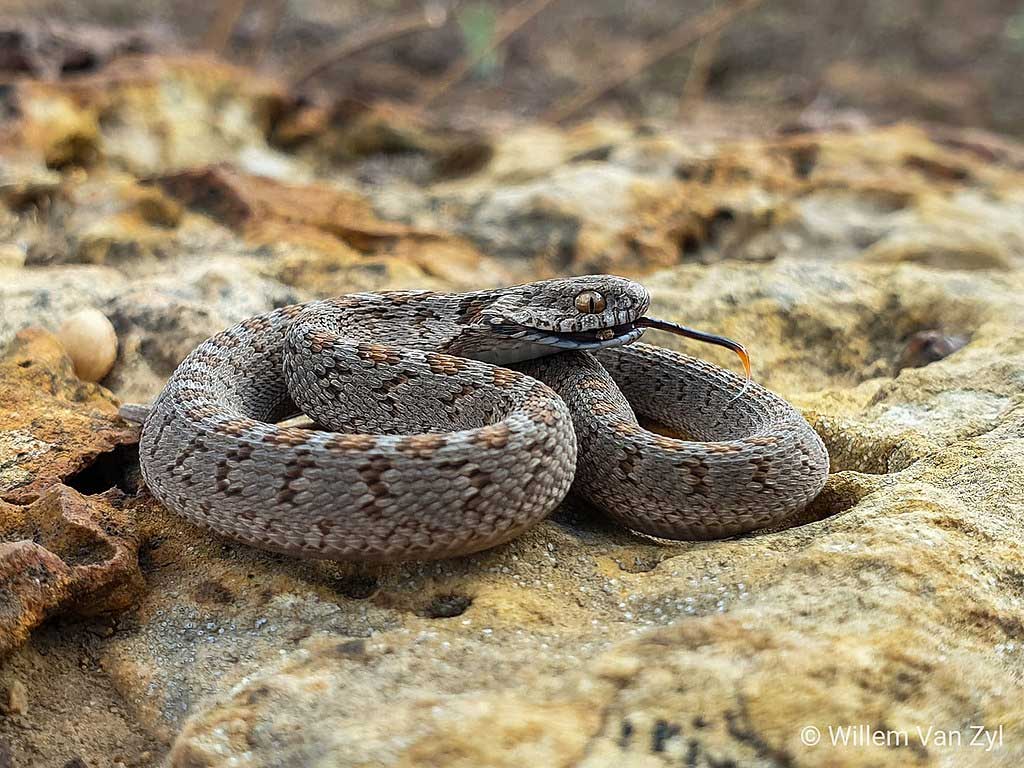
Content |
|---|
Description
The Egg-eating snake bears the scientific name of Dasypeltis scabra. This interesting species of snake belongs to the family of terrestrial and arboreal snakes. (Colubrinae).
From a visual point of view, it can be said that the Dasypeltis scabra can grow to a total size of almost 110 cm.. The body itself is slender and has a rounded head..
The coloration of the Egg-eating snake is not uniform. Depending on the species and specimen, can adopt a brownish body coloration, greyish or olive green.
Habitat and behavior
The natural habitat of the Dasypeltis scabra are the forests and savannahs of northeastern and southern Africa and the Arab region. It is especially widespread in Egypt, Angola, Eritrea, Somalia and Saudi Arabia.
The Egg-eating snake is nocturnal. They remain hidden in hiding places during the day and only come out to prowl under cover of twilight.
To protect yourself from predators, the Egg-eating snake imitates the behavior of venomous snakes. In particular, there is no denying the parallel with the rhombic night adder (Causus rhombeatus). To confuse your attackers, snakes rub their lateral scales against each other and thus produce the well-known hisses.
Terrarium
The Egg-eating snake needs a semi-dry terrarium
This species of snake is not dangerous to humans.
Land and tree snakes are ideal for keeping in a terrarium. This terrarium must be a semi-dry terrarium with a size of at least 100 x 50 x 100 cm..
In their natural habitats, the Dasypeltis scabra prefers to live in trees. This should be taken into account when assembling the terrarium. These snakes like to climb a lot. This should not change in the terrarium. As a caregiver, make sure your snakes always have enough climbing options. Especially the branches, trunks or climbing plants are willingly accepted by exotic snakes.
The Egg-eating snake is nocturnal and twilight. During the day, as already said, remain hidden in hiding places. So, it is advantageous to equip the terrarium with various hiding places and shelters. Caves are explicitly mentioned here, tubes and structures of rock or stone. Snakes also don't oppose a pool.
To the Dasypeltis scabra likes warmth and comfort. For animal welfare, in the terrarium should always prevail an ambient temperature of between 22 and 28 degrees Celsius. During the night hours, you can reduce the temperature to 22 degrees Celsius. Humidity, otherwise, it must be around the 60%.
Food
feed the Egg-eating snake in a way appropriate to the species is not always easy. These snakes are food specialists and feed exclusively on bird eggs.. In particular, quail eggs, finch or chicken eat them as a delicacy.
breeding of the Dasypeltis scabra in the terrarium
There are already some reports on the successful breeding of the Egg-eating snake (Dasypeltis scabra) in a terrarium. This is hard, but possible. A female can put up 25 eggs, that distributes throughout the terrarium. After a few 3 months, hatchlings hatch.
Buy one "Egg-eating snake"
The price of a "Egg-eating snake" in the exotic animal market ranges from 100 – 130 EUR.
Video Egg-eating snake
Alternative names:
1. Egg-eating snake, Common egg eater, Rhombic egg eater (English).
2. Serpent mangeur d’oeufs, Serpent mangeur d’oeufs commun (French).
3. Afrikanische Eierschlange, Dasypeltis scabra (German).
4. Cobra comedora de ovos, Comedor de ovo rômbico (Portuguese).
5. Serpiente rómbica (español).
